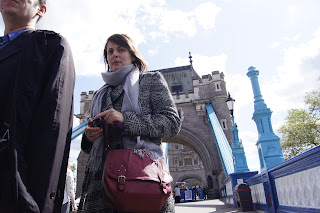I was surprised by this sway towards wider focal lengths rather than telephoto but I soon found as I started the project 'Close and involved' my experience with shooting for the day using the widest angle my lens would allow (18mm on an APS-C cropped sensor DSLR) correlated with what these street phtographers were saying.
First of all I found this project to be very enjoyable and very productive. There were many techniques and strategies I found and employed in the exercise. I could imagine they would prove useful later on and I certainly felt I was learning as I went along in the exercise. Here are a couple of shots taken before I had gotten familiar with using such a wide focal length:
 |
| 1. |
 |
| 2. |
The main problem with these two photos I felt was I hadn't realised just how much angle of view the wide angle focal length would provide and so the people in the frame didn't take up a large space within it. Also the portrait or landscape orientation mattered a lot more then with other focal
lengths. The portrait orientation offered the more dramatic view but was harder to capture face detail than the landscape orientation. Also the people within the frame were harder to frame with portrait orientation.Significantly, this meant you were suspect to getting 'caught'. This was because to fill up a large portion of the frame with the subject you had to get up very close. Here are a couple of photographs illustrating the dramatic view:
 |
| 3. |
 |
| 4. |
 |
| 5. |
Then I discovered the relationship between the person and the background was extremely pronounced in any orientation so the choice of background for me became critical. This was in stark contrast to the telephoto shots I had taken where the backgrounds were usually out-of-focus so were much more malleable in conceiving a sense of place as the setting was much less obvious. Rather than photgraphing a particularly interesting subject coupled with an ambiguous place I had to be more careful in finding attractive settings for whichever subject.
Last but not least I experimented with using a low camera angle to add to the 'drama' and was pleasantly surprised with how well this worked.
Armed with all this knowledge I went in search of an attractive setting with lots of people to 'choose' from. After consulting a street map I saw Tower Bridge wasn't to far away. Soon I had quite a dubious technique for getting the pictures I wanted nailed down. This consisted of me casually walking up to the subject, crouching down and snapping them without so much as looking at the camera. The effect this had was to achieve some dramatic shots as well as plenty of dirty looks!
 |
| 6. |
 |
| 7. |
 |
| 8. |
 |
| 9. |
 |
| 10. |
 |
| 11. |
 |
| 12. |
 |
| 13. |
 |
| 14. |
 |
| 15. |
 |
| 16. |
 |
| 17. |
 |
| 18. My favourite from the session because of his expression |
 |
| 19. |
No comments:
Post a Comment